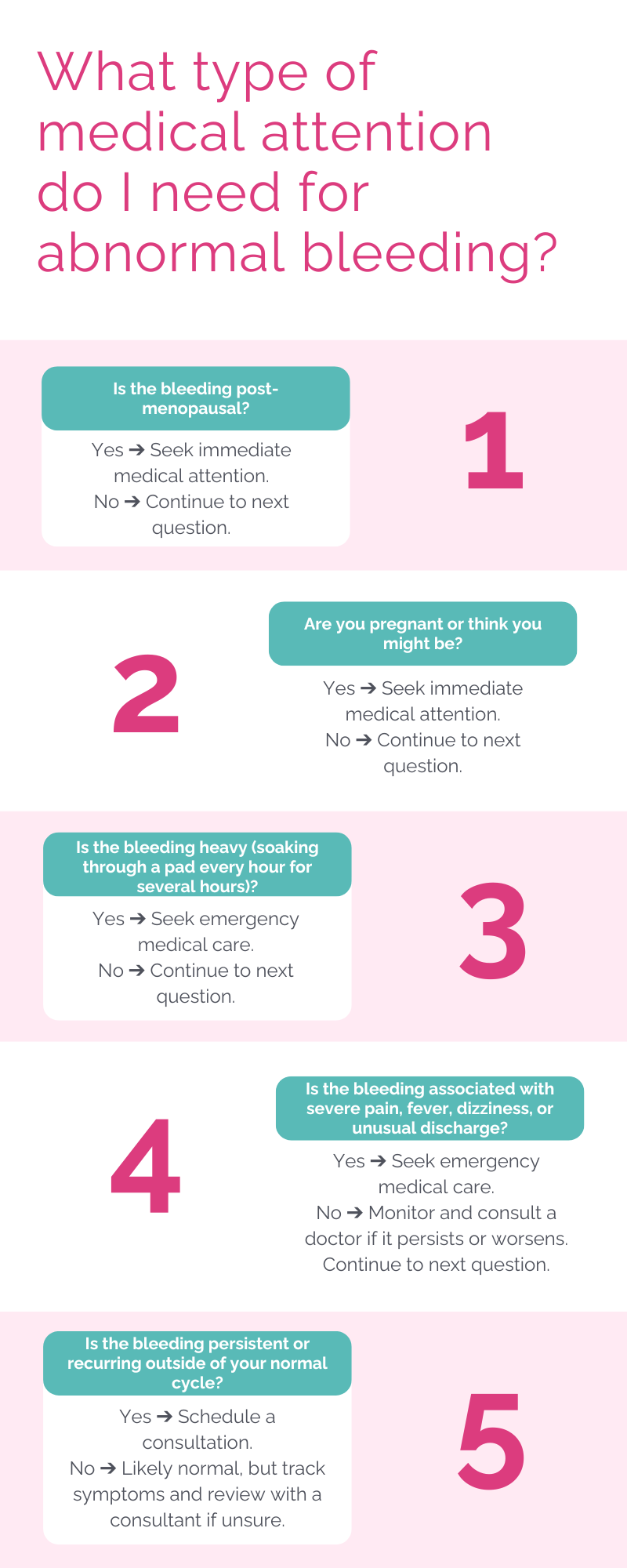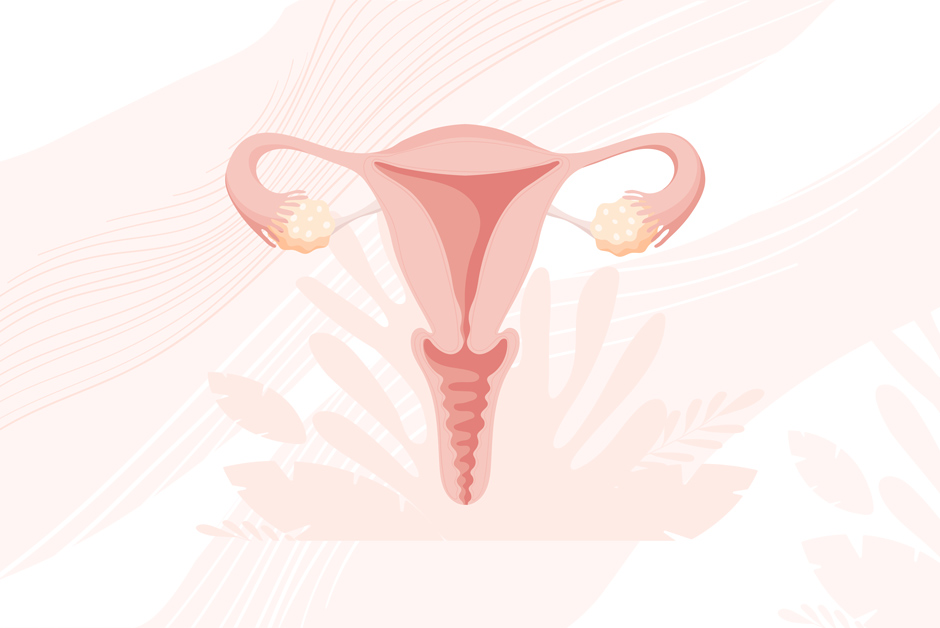Abnormal vaginal bleeding refers to any unexpected or irregular bleeding from the vagina. It is sometimes confused with Abnormal Uterine Bleeding (AUB), though this refers to abnormal bleeding specifically from the uterus.
Understandably, any bleeding that is not normal for you might cause you to worry – but it doesn’t necessarily mean that something is seriously wrong. Abnormal bleeding has a number of causes including those that relate to hormones and hormonal contraception, non-cancerous growths such as fibroids, or vaginal dryness.
Abnormal bleeding is a common symptom, affecting up to one third of women in their lifetime. It can happen at any age, though bleeding before the age of 10 is rare and should be investigated. It can also affect people from any ethnic background.
As Mr Alex Steshenko, Consultant Gynaecologist at The Gynae Centre, explains, “A typical menstrual cycle lasts for 28 days, but there is a lot of variation from woman to woman. This means that abnormal bleeding could simply be the result of an irregular cycle, or it could point to a medical condition, and it can be hard to distinguish between the two without the appropriate investigations. The bottom line is, if the bleeding is not typical for you, then you should seek advice from a gynaecologist. It’s likely that it’s nothing serious, but a consultation can confirm that, and bring you peace of mind.”
Abnormal bleeding and the menstrual cycle
Abnormal bleeding is often linked to irregularities in the menstrual cycle. While a typical cycle is around 28 days, many women experience shorter or longer cycles, and these variations can be perfectly normal.
However, bleeding between periods (intermenstrual bleeding), unusually heavy periods (menorrhagia), or periods that last much longer than usual may be signs of underlying issues.
Hormonal imbalances, such as those caused by polycystic ovary syndrome (PCOS) or thyroid conditions, are common culprits.
Bleeding after sex
Bleeding after intercourse (postcoital bleeding) can be alarming but is not always a sign of something serious. Common causes include vaginal dryness, cervical ectropion (a harmless condition where cells from inside the cervix are present on its outer surface), or inflammation from an infection. However, it can also be associated with polyps or, less commonly, cervical cancer.
Any persistent or recurring bleeding after sex should be assessed by a healthcare provider.
Abnormal bleeding during pregnancy
Any bleeding during pregnancy should be reported to a healthcare provider. While light spotting can be normal, especially in early pregnancy, heavier bleeding may signal a problem such as miscarriage, ectopic pregnancy or placenta previa (where the placenta partially or completely covers the cervix).
An assessment, including ultrasound, is essential to determine the cause and ensure the health of both the mother and the pregnancy.
Abnormal bleeding during perimenopause
As oestrogen levels fluctuate in the years leading up to menopause, cycles often become irregular. This can lead to changes in bleeding patterns, including heavier or lighter periods, longer times between periods, or bleeding at unexpected times.
While some irregular bleeding is normal in perimenopause, it should still be discussed with a gynaecologist to rule out other causes.
Post-menopausal bleeding
Any bleeding after menopause (defined as 12 months without a period) is considered abnormal and should be investigated. Although it may be due to something minor like vaginal dryness or vaginal atrophy (thinning of the vaginal lining), it can also be a sign of more serious conditions such as endometrial cancer. Don’t delay in seeking medical attention.
Other causes of abnormal vaginal bleeding
Aside from hormonal or structural causes, abnormal bleeding can be caused by:
- Infections and related conditions, such as sexually transmitted infections and pelvic inflammatory disease
- Medications, such as blood thinners
- Bleeding disorders, such as haemophilia, a vitamin K deficiency, or Von Willebrand disease
- Trauma
- Recent surgical procedures
- Foreign object in the vagina, including a birth control device such as intrauterine device (IUD)
Can you bleed from stress?
While stress doesn’t typically cause bleeding directly, it can affect your hormonal imbalance, which in turn can lead to irregular cycles or spotting. Chronic stress impacts the hypothalamic-pituitary-ovarian axis, disrupting ovulation and potentially causing missed or unpredictable periods.
What does stress bleeding look like?
Stress-related bleeding often appears as light spotting outside of your usual period. It may also delay or temporarily stop your cycle. If this pattern persists or worsens, it’s a good idea to see a healthcare provider to rule out other causes.
When should you seek medical attention for abnormal bleeding?
If your bleeding is unusual for you in terms of timing, amount, duration, or if it’s accompanied by other symptoms, it’s time to see a medical professional.
Most likely, it may be diagnosed with one of the following causes:
- Hormonal imbalances: Conditions like PCOS or thyroid disorders
- Structural abnormalities: Fibroids, polyps, endometriosis or adenomyosis
- Bleeding disorders: Such as haemophilia, a vitamin K deficiency or Von Willebrand disease
- Infections: Including STIs and pelvic inflammatory disease
How abnormal vaginal bleeding is diagnosed
When investigating abnormal vaginal bleeding, your consultant gynaecologist will ask about your symptoms and address any contributing factors with the aim of spotting any red flags, before suggesting relevant investigations to help reach a diagnosis. This process may consist of:
Medical history
Your doctor will ask about your cycle, symptoms, family history and lifestyle.
Physical exam
A pelvic examination can help spot infections, growths or signs of trauma. This usually involves your consultant inserting a speculum into your vagina to closely examine the vaginal canal and cervix. They may also use a strong light and magnifier.
Your consultation may also want to physically examine your pelvic organs, which involves inserting two gloved fingers into your vagina, and pressing down on your lower abdomen with their other hand.
If either of these examinations feel too uncomfortable or painful, you can let your consultant know that you’d like to stop.
Imaging tests
A pelvic ultrasound may be used to visualise the uterus and identify abnormalities. This could be a transabdominal ultrasound, which is a non-invasive scan where the probe is passed over your lower abdomen. Alternatively, it may be a transvaginal ultrasound, where a probe is inserted into the vagina to provide more detailed images of the gynaecological organs.
A hysteroscopy is also commonly used to investigate abnormal vaginal bleeding. This is where a thin, tube-like telescope containing a small camera is inserted into the uterus through the vagina and cervix. A hysteroscopy itself can cause some spotting and cramping, but this should go away after a few days.
Lab tests
These may include blood tests to check hormone levels, clotting function and infection markers.
Below is a helpful flowchart to help you decide what type of medical attention to seek according to your symptoms and other influential factors:

If you have abnormal vaginal bleeding and would like to book a consultation with one of our expert consultant gynaecologists, please call us on 020 7580 8090 or book online.






